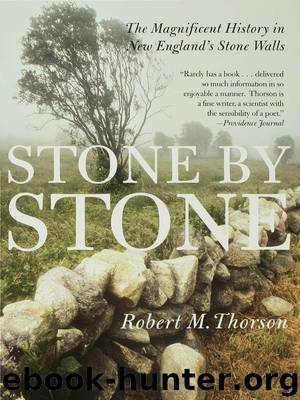Stone by Stone by Robert Thorson

Author:Robert Thorson
Language: eng
Format: epub
Publisher: Bloomsbury Publishing Plc
Published: 2009-12-08T16:00:00+00:00
A few stone walls were built above well-drained, frost-free foundations. Here, the recommended procedure was to lay out a straight line, excavate a shallow trench to remove the fine-grained material that wicked water beneath the stones during freezing, and backfill it with gravel before skidding or rolling the basal stones into place. Usually, however, only the loose organic debris was stripped away. Then the actual stonework could begin.
When building walls, New England farmers used simple rules governed by the laws of mechanics, a branch of physics dealing with mass and motion. The field of mechanics includes both statics, the stability of materials at rest (which governs the shape of stone walls and the internal arrangement of its stones), and dynamics (the forces and movements associated with moving the stones). Both were equally important in the construction of stone walls, regardless of when or where.
With respect to "statics," the most important principle was to lay the stones down in horizontal tiers with their edges butted together. Each successive tier of stones was laid so that the gaps in one tier did not coincide with the gaps in the one above it. This principle, known as one-on-two and two-on-one, is perfectly expressed by brickwork. A second principle was to place the largest stones (especially if they were irregular) near the base of a wall where they could serve as a foundation for the smaller stones above them. Finally, walls were tapered upward, or "battered," to keep them from tipping over.8
The majority of a farmer's walls were little more than stacks of stones perched precariously upon one another. Closer to the house and barn, and nearly always around cemeteries, stone walls were usually built, from the start, with some care. Most often, they were built of both sides, forming a "double-faced wall." WTienever possible, the straightest and thickest edge of each stone was placed on the outside, and each was positioned so that it slanted inward toward the center of the wall. This technique helped make walls stronger with time because the stones pressed more tightly together as the wall settled. The center of each double wall, where the thin and irregular edges of both sides met, was usually filled with rubble and pebbles. As the walls were built upward from their boulder foundations, they were leveled off to create a roughly rectangular cross section, upon which a final tier of "capstones" was placed.
Capstones were slabs large enough to span both sides of a double-faced wall, heavy enough to press them together, and flat enough to be attractive; often they were culled from stone piles and reserved for the final tier, especially at gates and corners. Another specialty stone was called a thrufter. These elongated, almost spindle-shaped stones were placed inside a wall to help bind its two sides together. This was especially important at corners, where the stones from one wall could be overlapped with those of the other, like the logs of a log cabin or the dovetails in a wooden drawer.
Download
This site does not store any files on its server. We only index and link to content provided by other sites. Please contact the content providers to delete copyright contents if any and email us, we'll remove relevant links or contents immediately.
The Lonely City by Olivia Laing(4750)
Animal Frequency by Melissa Alvarez(4395)
All Creatures Great and Small by James Herriot(4233)
Walking by Henry David Thoreau(3894)
Exit West by Mohsin Hamid(3778)
Origin Story: A Big History of Everything by David Christian(3649)
COSMOS by Carl Sagan(3554)
How to Read Water: Clues and Patterns from Puddles to the Sea (Natural Navigation) by Tristan Gooley(3409)
Hedgerow by John Wright(3276)
The Inner Life of Animals by Peter Wohlleben(3259)
How to Read Nature by Tristan Gooley(3249)
How to Do Nothing by Jenny Odell(3232)
Project Animal Farm: An Accidental Journey into the Secret World of Farming and the Truth About Our Food by Sonia Faruqi(3178)
Origin Story by David Christian(3148)
Water by Ian Miller(3128)
A Forest Journey by John Perlin(3027)
The Plant Messiah by Carlos Magdalena(2883)
A Wilder Time by William E. Glassley(2818)
Forests: A Very Short Introduction by Jaboury Ghazoul(2790)
